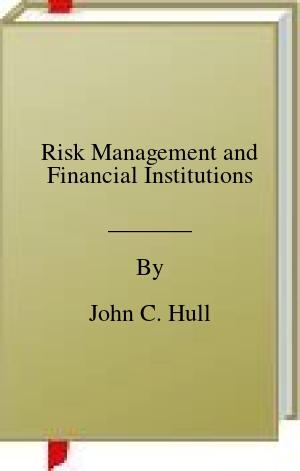Risk Management and Financial Institutions Fifth Edition by John C. Hull

Chapter 1
Introduction
Imagine you are the Chief Risk Officer (CRO) of a major corporation.
The Chief Executive Officer (CEO) wants your views on a major new
venture. You have been inundated with reports showing that the new
venture has a positive net present value and will enhance shareholder
value. What sort of analysis and ideas is the CEO looking for from you?
As CRO it is your job to consider how the new venture fits into the
company's portfolio. What is the correlation of the performance of the
new venture with the rest of the company's business? When the rest of
the business is experiencing difficulties, will the new venture also
provide poor returns, or will it have the effect of dampening the ups and
downs in the rest of the business?
Companies must take risks if they are to survive and prosper. The risk
management function's primary responsibility is to understand the
portfolio of risks that the company is currently taking and the risks it
plans to take in the future. It must decide whether the risks are acceptable
and, if they are not acceptable, what action should be taken.
Most of this book is concerned with the ways risks are managed by
banks and other financial institutions, but many of the ideas and
approaches we will discuss are equally applicable to nonfinancial
corporations. Risk management has become progressively more
important for all corporations in the last few decades. Financial
institutions in particular are finding they have to increase the resources
they devote to risk management. Large “rogue trader” losses such as
those at Barings Bank in 1995, Allied Irish Bank in 2002, Société
Générale in 2007, and UBS in 2011 would have been avoided if
procedures used by the banks for collecting data on trading positions had
been more carefully developed. Huge subprime losses at banks such as
Citigroup, UBS, and Merrill Lynch would have been less severe if risk
management groups had been able to convince senior management that
unacceptable risks were being taken.
This chapter sets the scene. It starts by reviewing the classical arguments
concerning the risk‐return trade‐offs faced by an investor who is
choosing a portfolio of stocks and bonds. It then considers whether the
same arguments can be used by a company in choosing new projects and
managing its risk exposure. The chapter concludes that there are reasons
why companies—particularly financial institutions—should be
concerned with the total risk they face, not just with the risk from the
viewpoint of a well‐diversified shareholder.
1.1 Risk vs. Return for Investors
As all fund managers know, there is a trade‐off between risk and return
when money is invested. The greater the risks taken, the higher the return
that can be realized. The trade‐off is actually between risk and expected
return, not between risk and actual return. The term “expected return”
sometimes causes confusion. In everyday language an outcome that is
“expected” is considered highly likely to occur. However, statisticians
define the expected value of a variable as its average (or mean) value.
Expected return is therefore a weighted average of the possible returns,
where the weight applied to a particular return equals the probability of
that return occurring. The possible returns and their probabilities can be
either estimated from historical data or assessed subjectively.
Suppose, for example, that you have $100,000 to invest for one year.
Suppose further that Treasury bills yield 5%.1
One alternative is to buy
Treasury bills. There is then no risk and the expected return is 5%.
Another alternative is to invest the $100,000 in a stock. To simplify
things, we suppose that the possible outcomes from this investment are
as shown in Table 1.1. There is a 0.05 probability that the return will be
+50%; there is a 0.25 probability that the return will be +30%; and so on.
Expressing the returns in decimal form, the expected return per year is:
This shows that, in return for taking some risk, you are able to increase
your expected return per annum from the 5% offered by Treasury bills to
10%. If things work out well, your return per annum could be as high as
50%. But the worst‐case outcome is a −30% return or a loss of $30,000.
Risk Management and Financial Institutions Fifth Edition by John C. Hull




